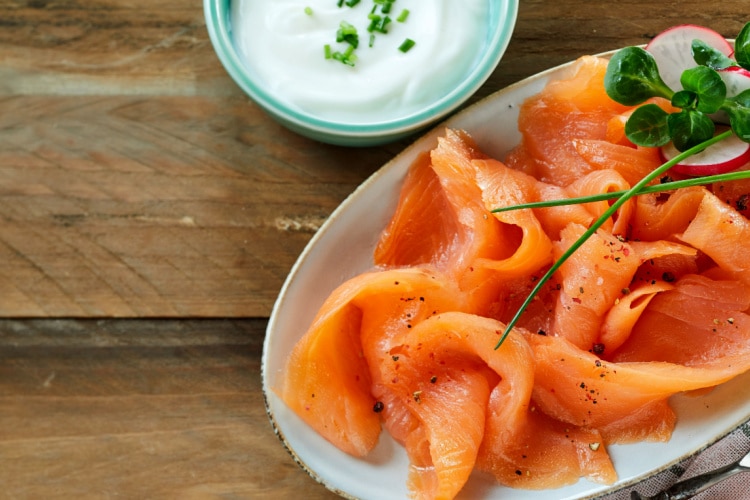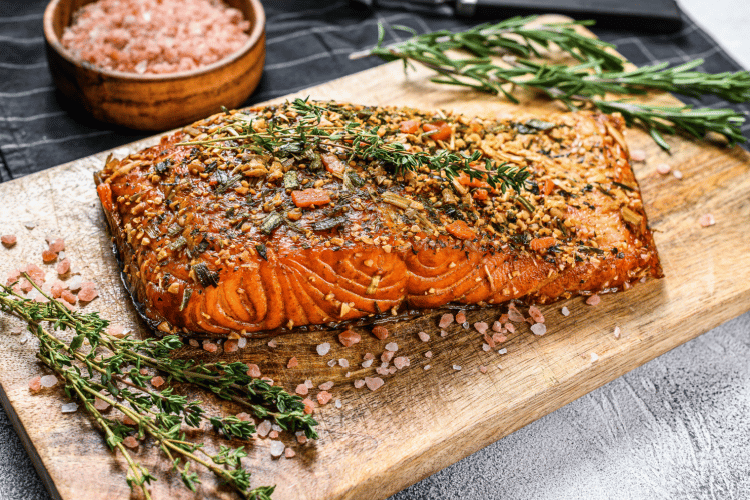You’re in the middle of a New York City buzz, craving for some authentic New York City bagel, and the deli chef suddenly asks you: “Do you want your bagel with smoked salmon or lox?” But how can you distinguish between these two popular bagel additions that almost look identical?
Well, it turns out that even though both smoked salmon and lox come from the same fish, they are prepared differently. Smoked salmon is cured or brined and smoked. Lox, on the other hand, is cured but not smoked.
The preserving technique, however, is merely a starting stone. In this article, you’ll learn all of them. Let’s go!
Difference Between Lox vs. Smoked Salmon

Lox and smoked salmon derive from the same fish, salmon — however, the smoking procedure is what sets them apart. Lox is never smoked, whereas smoked salmon – as the name states – is always smoked.

Now let’s look at each difference separately.
Origin
Lox comes from Scandinavia, where the people discovered how to preserve salmon in saltwater brine early on. Apart from the Scandinavians, Jews from Eastern Europe were also fond of curing salmon. The current name echoes this, as the Yiddish word for salmon is “laks.”
The popularity of smoked salmon developed during the Middle Ages, but the smoked salmon industry boomed in the nineteenth century, notably along America’s West Coast. The waterways of Alaska and Oregon are famous for the gorgeous Pacific salmon. Smoked salmon was especially popular during WWII when soldiers smoked the fish to keep it fresh throughout lengthy journeys.
Preparation
Preparing lox and smoked salmon begins by deboning the salmon. While smoked salmon uses the entire side of the fish for curing and smoking, lox uses only the richest, fattest, and most delicious part — the belly.
As for the skin, some cooks advise leaving the skin on to make the fish more solid, however, the fish soaks the cure more effectively without it. Plus, not only does the skin give a peculiar, often unpleasant aroma to the fish, but it can also get mushy and soggy when smoked. That’s why it’s better to remove the skin while you cut the fish.
Preservation
As already noted, both lox and smoked salmon undergo the same curing process. Curing helps the salmon retain its freshness longer, improves the mouthfeel, and enhances the flavor.
Lox and smoked salmon can be wet-cured or dry-cured.
- Dry cure: Lox or smoked salmon sits in salt, sugar, and sometimes lemon zest for up to three days.
- Wet cure: Preparing a brine with salt and sugar, then immersing the lox or smoked salmon for six to ten hours.
Curing is the last step in making lox. Although the lox isn’t cooked during this procedure, it has a lovely buttery, silky feel and may be eaten raw without further cooking.
Smoked salmon, on the other hand, continues its preservation journey — up in the smoker. Salmon can be cold-smoked or hot-smoked.
- Cold smoking: The salmon is smoked in an 80°F (26°C) smoker. It’s still technically raw like the lox but has an extra smoky taste.
- Hot smoking: The salmon is put in a 150/160°F (65/70°C) smoker and smoked until it reaches a temperature of 140°F (60/65°C). This process takes between one to three hours, depending on the size of the filet. The salmon is then cooked in the oven until it reaches 150°F (65°C).
Color, Texture, Aroma & Flavor
Lox and cold smoked salmon have a similar pinkish-orange color, whereas hot-smoked salmon has a more intense, dark orange color.
Lox and cold-smoked salmon have smooth and silky textures, while hot-smoked salmon is more crisp and flaky. The former feels a little sticky to the touch since they are essentially uncooked, while the latter remains solid and meaty.
Smoked salmon and lox both have strong but flavorful scents — but the bonus smoky aroma of the smoked salmon makes it easily recognizable and more delectable.
Both flavors are typically fishy, salty, and herbal. Lox typically has a saltier taste than smoked salmon. On the other hand, the delicious taste of the wood chips will give smoked salmon an extra boost in flavor.
Shelf Life
A sealed pack of lox can survive for up to two months in the fridge. Additionally, you may freeze lox to extend its shelf life. Although frozen lox may be kept for up to 6 months, it’s preferable to use it within 3 months as the quality will weaken with time. Once you open it, you should consume lox within three days.
In the refrigerator, hot smoked salmon can keep for about two weeks. It can also remain fresh and tasty if frozen for up to three months. Cold smoked salmon has a shelf life of 1 week in the fridge and around 1 month in the freezer.
Once frozen, it can maintain its flavor for two to three months. Smoked salmon must be refrigerated and used within 5-7 days of opening.
Cooking
Because lox and cold-smoked salmon are somewhat raw, you may serve them without cooking them. Hot smoked salmon, on the other hand, is completely cooked and a preferable option for dishes that call for additional cooking.
The traditional New York bagel that initially perplexed us usually includes cold-smoked salmon or lox. The raw delicacies are also great with pretzels, salads, or layered on an appetizer platter.
Cooked dishes can employ cold-smoked salmon or lox, but hot-smoked salmon is the more suitable and tastier combination. It works amazingly well in omelets, grilled cheese, spaghetti, fried rice, soups, mashed potatoes, tart, or creamy dips, and it’s also an option to choose from when ordering the classic New York bagel.
Lox vs. Smoked Salmon Comparison Table
| Category | Lox | Smoked Salmon |
| Origin | Scandinavia | Native American |
| Type of fish | Salmon | Salmon |
| Part of the fish | Belly | Whole side |
| Preparation | Cured or brined | Cured or brined, and smoked (hot or cold-smoked) |
| Color | Pinkish-orange | Cold Smoked salmon: pinkish-orange Hot-smoked salmon: dark orange |
| Texture | Velvety & soft | Cold-smoked salmon: smooth Hot-smoked salmon: flaky |
| Aroma | Fishy, salty | Fishy and smoky |
| Flavor | Salty | Salty and smoky |
| Shelf life | Sealed: Refrigerated: 2 monthsFrozen: 3 months Opened: Refrigerated: 3 daysFrozen: 3-6 months | Hot-smoked salmon: Refrigerated: 2 weeksFrozen: 3 monthsOpened: 5-7 days Cold-smoked salmon: Refrigerated: 1 weekFrozen: 1 monthOpened: 5-7 days |
| Cooking | Mostly preferred for cold meals, but may also be cooked | Hot-smoked salmon: Mostly combined with recipes that require cooking; Cold-smoked salmon: Usually preferred with cold meals, but may also be cooked |
Nutritional Content Breakdown: Which One Is Healthier?
According to the nutritional chart below, lox has lower levels of calories, fat, and cholesterol. However, it has a far greater salt concentration than smoked salmon, making it the less healthy option.
On the other hand, smoked salmon has a greater protein content and cold-smoked salmon, in particular, has the greatest levels of calcium and iron.
Although lox is lower in calories, fats, and cholesterol, it has high salt content. As you might know, it’s strongly advised against consuming too much salt since it might cause cardiac issues. Furthermore, lox is a raw fish, making it a poor choice for those with sensitive stomachs.
Lox vs. Smoked Salmon: Nutritional Profile
| Category (100g) | Lox | Cold-Smoked Salmon | Hot-Smoked Salmon |
| Calories | 99 | 110 | 193 |
| Carbs | 0g | 0g | 0.9g |
| Fat | 3.7g | 4g | 12.3g |
| Saturated fat | 0.8g | 1g | 2.1g |
| Cholesterol | 20 mg | 45 mg | 46.8 mg |
| Sodium | 1.7g | 900 mg | 593.3 mg |
| Potassium | 149 mg | 330mg | 308.6 mg |
| Protein | 16g | 18g | 19.3g |
| Fiber | 0g | 0g | 0g |
| Sugars | 0g | 0g | 0g |
| Vitamins & Minerals | |||
| Vitamin A | 1.5% | 1.5% | 1% |
| Calcium | 0.7% | 2% | 0% |
| Iron | 4% | 5% | 0% |
Can I Substitute Lox for Smoked Salmon & Vice Versa?
Yes, you can definitely substitute smoked salmon for lox and vice versa. But there are a couple of things you should be mindful of:
If you want the velvety and smooth mouthfeel of lox, avoid hot-smoked salmon since it has a flaky texture, and use cold-smoked salmon instead.
Also, you shouldn’t anticipate any smokey flavor if you replace smoked salmon with lox. Instead, your dish will be saltier since lox has higher sodium content.
If you can’t find smoked salmon and lox is all you’ve got, you can always smoke the fish in the oven. Set the lox on the top rack, add the wood chips to an iron pan on the bottom shelf and bake for at least 15 minutes.
Conclusion
And that’s all you need to know about salmon and lox!
I hope that next time you’re waiting in line to get a bagel, you won’t struggle to pick your topping! Lox is raw salmon and is super salty, whereas smoked salmon is smoky and can be partially raw (cold-smoked) or fully cooked (hot-smoked). Whichever option you go for, you are up for a tasty treat! Enjoy.







